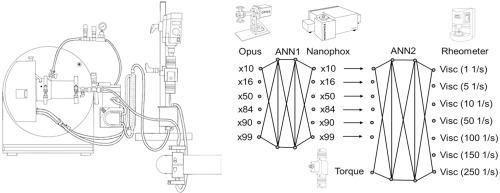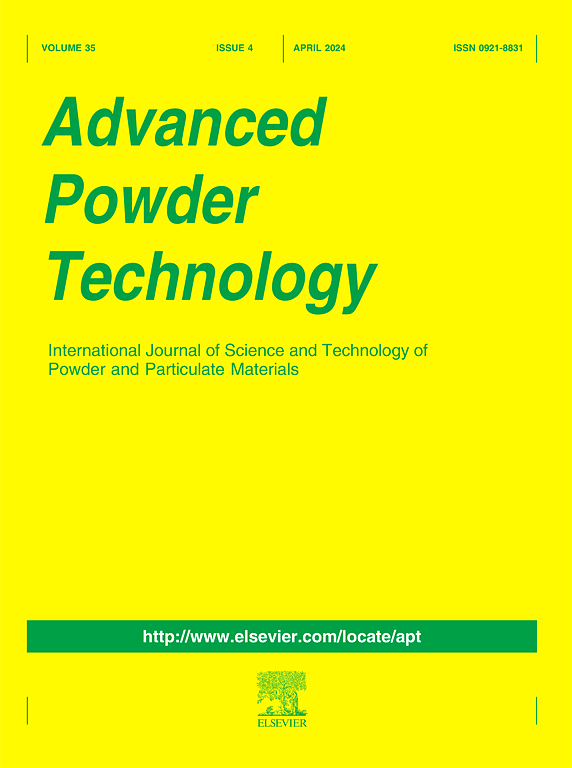用于搅拌介质磨机的人工智能驱动软传感器,用于实时过程控制
IF 4.2
2区 工程技术
Q2 ENGINEERING, CHEMICAL
引用次数: 0
摘要
粒度分布(PSD)和粘度的实时监测在湿磨中仍然是一个挑战,特别是由于它们复杂的相互依赖性。本研究提出了一个顺序神经网络架构,通过软测量方法预测这两个参数,消除了离线采样和稀释的需要。该方法通过超声波消光测量来预测PSD,并利用这些预测来估计悬浮液粘度。值得注意的是,该系统涵盖了一系列粒径和粘度值,这使得精确的实时测量和建模变得复杂。实验验证在实验室规模的搅拌介质磨机上进行,在不同的操作条件下处理Al2O3悬浮液,参数包括尖端速度(6-12 m/s),颗粒尺寸(300-700 μm)和固体质量浓度(10 - 30%)。利用数据增强增强模型鲁棒性,该体系结构达到了较好的精度(R2 >;0.85)的PSD预测和0.82的粘度预测。该模型成功捕获了过程动力学,包括颗粒尺寸减小到400nm以下引发显着流变变化的过渡点。灵敏度分析表明,磨尖速度和磨头直径是影响预测精度的最重要参数。这种连续的方法可以实现连续的实时过程监控,并为磨削操作的高级控制策略奠定了基础。本文章由计算机程序翻译,如有差异,请以英文原文为准。

AI-driven soft-sensor for stirred media mills for real-time process control
Real-time monitoring of particle size distribution (PSD) and viscosity remains a challenge in wet grinding, particularly due to their complex interdependence. This study presents a sequential neural network architecture that predicts both parameters via a soft-sensor approach, eliminating the need for offline sampling and dilution. The approach predicts the PSD from ultrasonic extinction measurements and uses these predictions to estimate suspension viscosity. Notably, the system covers a range of particle sizes and viscosity values, which complicates accurate real-time measurements and modelling. Experimental validations are carried out on a laboratory-scale stirred media mill processing Al2O3 suspensions across operating conditions, with parameters including tip speeds (6–12 m/s), bead sizes (300–700 μm), and solids mass concentrations (10–30 %). Using data augmentation to enhance model robustness, the architecture achieves good accuracy (R2 > 0.85) for PSD predictions and 0.82 for viscosity predictions. The model successfully captures process dynamics, including transition points where particle size reduction below 400 nm triggers significant rheological changes. A sensitivity analysis identifies mill tip speed and grinding bead diameter as the most influential parameters affecting prediction accuracy. This sequential approach enables continuous real-time process monitoring and lays the foundation for advanced control strategies in grinding operations.
求助全文
通过发布文献求助,成功后即可免费获取论文全文。
去求助
来源期刊

Advanced Powder Technology
工程技术-工程:化工
CiteScore
9.50
自引率
7.70%
发文量
424
审稿时长
55 days
期刊介绍:
The aim of Advanced Powder Technology is to meet the demand for an international journal that integrates all aspects of science and technology research on powder and particulate materials. The journal fulfills this purpose by publishing original research papers, rapid communications, reviews, and translated articles by prominent researchers worldwide.
The editorial work of Advanced Powder Technology, which was founded as the International Journal of the Society of Powder Technology, Japan, is now shared by distinguished board members, who operate in a unique framework designed to respond to the increasing global demand for articles on not only powder and particles, but also on various materials produced from them.
Advanced Powder Technology covers various areas, but a discussion of powder and particles is required in articles. Topics include: Production of powder and particulate materials in gases and liquids(nanoparticles, fine ceramics, pharmaceuticals, novel functional materials, etc.); Aerosol and colloidal processing; Powder and particle characterization; Dynamics and phenomena; Calculation and simulation (CFD, DEM, Monte Carlo method, population balance, etc.); Measurement and control of powder processes; Particle modification; Comminution; Powder handling and operations (storage, transport, granulation, separation, fluidization, etc.)
 求助内容:
求助内容: 应助结果提醒方式:
应助结果提醒方式:


